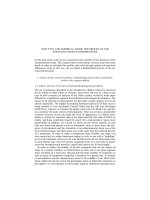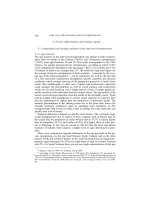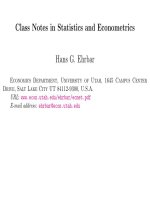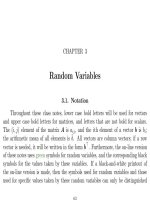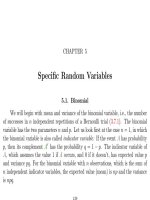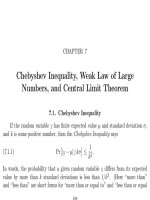Class Notes in Statistics and Econometrics Part 2 pptx
Bạn đang xem bản rút gọn của tài liệu. Xem và tải ngay bản đầy đủ của tài liệu tại đây (548.27 KB, 75 trang )
CHAPTER 3
Random Variables
3.1. Notation
Throughout these class notes, lower case bold letters will be used for vectors
and upper case bold letters for matrices, and letters that are not bold for scalars.
The (i, j) element of the matrix A is a
ij
, and the ith element of a vector b is b
i
;
the arithmetic mean of all elements is
¯
b. All vectors are column vectors; if a row
vector is needed, it will be written in the form b
. Furthermore, the on-line version
of these notes uses green symbols for random variables, and the corresponding black
symbols for the values taken by these variables. If a black-and-white printout of
the on-line version is made, then the symbols used for random variables and those
used for specific values taken by these random variables can only be distinguished
63
64 3. RANDOM VARIABLES
by their grey scale or cannot be distinguished at all; therefore a special monochrome
version is available which should be used for the black-and-white printouts. It uses
an upright math font, called “Euler,” for the random variables, and the same letter
in the usual slanted italic font for the values of these random variables.
Example: If y is a random vector, then y denotes a particular value, for instance
an observation, of the whole vector; y
i
denotes the ith element of y (a random scalar),
and y
i
is a particular value taken by that element (a nonrandom scalar).
With real-valued random variables, the powerful tools of calculus become avail-
able to us. Therefore we will begin the chapter about random variables with a
digression about infinitesimals
3.2. Digression about Infinitesimals
In the following pages we will recapitulate some basic facts from calculus. But
it will differ in two respe cts from the usual calculus classes. (1) everything will be
given its probability-theoretic interpretation, and (2) we will make explicit use of
infinitesimals. This last point bears some explanation.
You may say infinitesimals do not exist. Do you know the story with Achilles and
the turtle? They are racing, the turtle starts 1 km ahead of Achilles, and Achilles
runs ten times as fast as the turtle. So when Achilles arrives at the place the turtle
started, the turtle has run 100 meters; and when Achilles has run those 100 meters,
3.2. DIGRESSION ABOUT INFINITESIMALS 65
the turtle has run 10 meters, and when Achilles has run the 10 meters, then the turtle
has run 1 meter, etc. The Greeks were actually arguing whether Achilles would ever
reach the turtle.
This may sound like a joke, but in some respects, modern mathematics never
went beyond the level of the Greek philosophers. If a modern mathematicien sees
something like
(3.2.1) lim
i→∞
1
i
= 0, or lim
n→∞
n
i=0
1
10
i
=
10
9
,
then he will probably say that the lefthand term in each equation never really reaches
the numb e r w ritten on the right, all he will say is that the term on the left comes
arbitrarily close to it.
This is like saying: I know that Achilles will get as close as 1 cm or 1 mm to the
turtle, he will get closer than any distance, however small, to the turtle, instead of
simply saying that Achilles reaches the turtle. Modern mathematical proofs are full
of races between Achilles and the turtle of the kind: give me an ε, and I will prove to
you that the thing will come at least as close as ε to its goal (so-called epsilontism),
but never speaking about the moment when the thing will reach its goal.
Of course, it “works,” but it makes things terribly cumbersome, and it may have
prevented people from seeing connections.
66 3. RANDOM VARIABLES
Abraham Robinson in [Rob74] is one of the mathematicians who tried to remedy
it. He did it by adding more numbers, infinite numbers and infinitesimal numbers.
Robinson showed that one can use infinitesimals without ge tting into contradictions,
and he demonstrated that mathematics becomes much more intuitive this way, not
only its eleme ntary proofs, but especially the deeper results. One of the elemrntary
books based on his calculus is [HK79].
The well-know logician Kurt G¨odel said about Robinson’s work: “I think, in
coming years it will be considered a great oddity in the history of mathematics that
the first exact theory of infinitesimals was developed 300 years after the invention of
the differential calculus.”
G¨odel called Robinson’s theory the first theory. I would like to add here the fol-
lowing speculation: perhaps Robinson shares the following error with the “standard”
mathematicians whom he criticizes: they consider numbers only in a static way, with-
out allowing them to move. It would be b e neficial to expand on the intuition of the
inventors of differential calculus, who talked about “fluxions,” i.e., quantities in flux,
in motion. Modern mathematicians even use arrows in their symbol for limits, but
they are not calculating with moving quantities, only with static quantities.
This perspective makes the category-theoretical approach to infinitesimals taken
in [MR91] especially promising. Category theory considers objec ts on the same
footing with their transformations (and uses lots of arrows).
3.2. DIGRESSION ABOUT INFINITESIMALS 67
Mayb e a few years from now mathematics will be done right. We should not let
this temporary backwardness of mathematics allow to hold us back in our intuition.
The equation
∆y
∆x
= 2x does not hold exactly on a parabola for any pair of given
(static) ∆x and ∆y; but if you take a pair (∆x, ∆y) which is moving towards zero
then this equation holds in the moment when they reach zero, i.e., when they vanish.
Writing dy and dx me ans therefore: we are looking at magnitudes which are in the
process of vanishing. If one applies a function to a moving quantity one again gets a
moving quantity, and the derivative of this function compares the speed with which
the transformed quantity moves with the speed of the original quantity. Likewise,
the equation
n
i=1
1
2
n
= 1 holds in the moment when n reaches infinity. From this
point of view, the axiom of σ-additivity in probability theory (in its equivalent form
of rising or declining sequences of events) indicates that the probability of a vanishing
event vanishes.
Whenever we talk about infinitesimals, therefore, we really mean magnitudes
which are moving, and which are in the process of vanishing. dV
x,y
is therefore not,
as one might think from what will be said below, a static but small volume element
located close to the point (x, y), but it is a volume element which is vanishing into
the point (x, y). The probability density function therefore s ignifies the speed with
which the probability of a vanishing element vanishes.
68 3. RANDOM VARIABLES
3.3. Definition of a Random Variable
The best intuition of a random variable would be to view it as a numerical
variable whose values are not determinate but follow a statistical pattern, and call
it x, while possible values of x are called x.
In order to make this a mathematically sound definition, one says: A mapping x :
U → R of the set U of all possible outcomes into the real numbers R is called a random
variable. (Again, mathematicians are able to construct pathological mappings that
cannot b e use d as random variables, but we let that be their problem, not ours.) The
green x is then defined as x = x(ω). I.e., all the randomness is shunted off into the
process of selecting an element of U . Instead of being an indeterminate function, it
is defined as a determinate function of the random ω. It is written here as x(ω) and
not as x(ω) because the function itself is determinate, only its argument is random.
Whenever one has a mapping x : U → R between sets, one can construct from it
in a natural way an “inverse image” mapping between subsets of these sets. Let F,
as usual, denote the set of subsets of U, and let B denote the set of subsets of R. We
will define a mapping x
−1
: B → F in the following way: For any B ⊂ R, we define
x
−1
(B) = {ω ∈ U : x(ω) ∈ B}. (This is not the usual inverse of a mapping, which
does not always exist. The inverse-image mapping always exists, but the inverse
image of a one-element set is no longer necessarily a one-element set; it may have
more than one element or may be the empty set.)
3.3. DEFINITION OF A RANDOM VARIABLE 69
This “inverse image” mapping is well behaved with respect to unions and inter-
sections, etc. In other words, we have identities x
−1
(A ∩B) = x
−1
(A) ∩x
−1
(B) and
x
−1
(A ∪ B) = x
−1
(A) ∪ x
−1
(B), etc.
Problem 44. Prove the above two identities.
Answer. These are a very subtle proofs. x
−1
(A ∩ B) = {ω ∈ U : x(ω) ∈ A ∩ B} = {ω ∈
U : x(ω) ∈ A and x(ω) ∈ B = {ω ∈ U : x(ω) ∈ A} ∩ {ω ∈ U : x(ω) ∈ B} = x
−1
(A) ∩ x
−1
(B). The
other identity has a similar proof.
Problem 45. Show, on the oth er hand, by a counterexample, that the “direct
image” mapping defined by x(E) = {r ∈ R : there exists ω ∈ E with x(ω) = r} no
longer satisfies x(E ∩ F) = x(E) ∩x(F).
By taking inverse images under a random variable x, the probability measure
on F is transplanted into a probability measure on the subsets of R by the simple
prescription Pr[B] = Pr
x
−1
(B)
. Here, B is a subset of R and x
−1
(B) one of U , the
Pr on the right side is the given probability measure on U, while the Pr on the left is
the new probability meas ure on R induced by x. This induced probability measure
is called the probability law or probability distribution of the random variable.
Every random variable induces therefore a probability measure on R, and this
probability measure, not the mapping itself, is the most important ingredient of
a random variable. That is why Amemiya’s first definition of a random variable
70 3. RANDOM VARIABLES
(definition 3.1.1 on p. 18) is: “A random variable is a variable that takes values
acording to a certain distribution.” In other words, it is the outcome of an experiment
whose set of possible outcomes is R.
3.4. Characterization of Random Variables
We will begin our systematic investigation of random variables with an overview
over all possible probability measures on R.
The simplest way to get such an overview is to look at the cumulative distribution
functions. Every probability measure on R has a cumulative distribution function,
but we will follow the common usage of assigning the cumulative distribution not
to a probability measure but to the random variable which induces this probability
measure on R.
Given a random variable x : U ω → x(ω) ∈ R. Then the cumulative distribu-
tion function of x is the function F
x
: R → R defined by:
(3.4.1) F
x
(a) = Pr[{ω ∈ U : x(ω) ≤ a}] = Pr[x≤a].
This function uniquely defines the probability measure which x induces on R.
3.4. CHARACTERIZATION OF RANDOM VARIABLES 71
Prop e rties of cumulative distribution functions: a function F : R → R is a cu-
mulative distribution function if and only if
a ≤ b ⇒ F(a) ≤ F (b)(3.4.2)
lim
a→−∞
F (a) = 0(3.4.3)
lim
a→∞
F (a) = 1(3.4.4)
lim
ε→0,ε>0
F (a + ε) = F (a)(3.4.5)
Equation (3.4.5) is the definition of continuity from the right (because the limit
holds only for ε ≥ 0). Why is a cumulative distribution function continuous from
the right? For every nonnegative sequence ε
1
, ε
2
, . . . ≥ 0 converging to zero which
also satisfies ε
1
≥ ε
2
≥ . . . follows {x ≤ a} =
i
{x ≤ a + ε
i
}; for these sequences,
therefore, the statement follows from what Problem 14 above said about the proba-
bility of the intersection of a declining set sequence. And a converging sequence of
nonnegative ε
i
which is not declining has a declining subsequence.
A cumulative distribution function need not be continuous from the left. If
lim
ε→0,ε>0
F (x −ε) = F(x), then x is a jump point, and the height of the jump is
the probability that x = x.
It is a matter of convention whether we are working with right continuous or
left continuous functions here. If the distribution function were defined as Pr[x < a]
72 3. RANDOM VARIABLES
(some authors do this, compare [Ame94, p. 43]), then it would be continuous from
the left but not from the right.
Problem 46. 6 points Assume F
x
(x) is the cumulative distribution function of
the random variable x (whose distribution is not necessarily continuous). Which of
the following formulas are correct? Give proofs or verbal justifications.
Pr[x = x] = lim
ε>0; ε→0
F
x
(x + ε) − F
x
(x)(3.4.6)
Pr[x = x] = F
x
(x) − lim
δ>0; δ→0
F
x
(x − δ)(3.4.7)
Pr[x = x] = lim
ε>0; ε→0
F
x
(x + ε) − lim
δ>0; δ→0
F
x
(x − δ)(3.4.8)
Answer. (3.4.6) does not hold gen erall y, since its rhs is always = 0; the other two equations
always hold.
Problem 47. 4 points Assume the distribution of z is symmetric about zero,
i.e., Pr[z < −z] = Pr[z>z] for all z. Call its cumulative distribution function F
z
(z).
Show that the cumulative distribution function of the random variable q = z
2
is
F
q
(q) = 2F
z
(
√
q) −1 for q ≥ 0, and 0 for q < 0.
3.4. CHARACTERIZATION OF RANDOM VARIABLES 73
Answer. If q ≥ 0 then
F
q
(q) = Pr[z
2
≤q] = Pr[−
√
q≤z≤
√
q](3.4.9)
= Pr[z≤
√
q] − Pr[z < −
√
q](3.4.10)
= Pr[z≤
√
q] − Pr[z>
√
q](3.4.11)
= F
z
(
√
q) − (1 −F
z
(
√
q))(3.4.12)
= 2F
z
(
√
q) − 1.(3.4.13)
Instead of the cumulative distribution function F
y
one can also use the quan-
tile function F
−1
y
to characterize a probability measure. As the notation suggests,
the quantile function can be considered some kind of “inverse” of the cumulative
distribution function. The quantile function is the function (0, 1) → R defined by
(3.4.14) F
−1
y
(p) = inf{u : F
y
(u) ≥ p}
or, plugging the definition of F
y
into (3.4.14),
(3.4.15) F
−1
y
(p) = inf{u : Pr[y≤u] ≥ p}.
The quantile function is only defined on the open unit interval, not on the endpoints
0 and 1, because it would often assume the values −∞ and +∞ on these endp oints,
and the information given by these values is redundant. The quantile function is
continuous from the left, i.e., from the other side than the cumulative distribution
74 3. RANDOM VARIABLES
function. If F is continuous and strictly increasing, then the quantile function is
the inverse of the distribution function in the usual sense, i.e., F
−1
(F (t)) = t for
all t ∈ R, and F(F
−1
((p)) = p for all p ∈ (0, 1). But e ven if F is flat on certain
intervals, and/or F has jump points, i.e., F does not have an inverse function, the
following important identity holds for every y ∈ R and p ∈ (0, 1):
(3.4.16) p ≤ F
y
(y) iff F
−1
y
(p) ≤ y
Problem 48. 3 points Prove equation (3.4.16).
Answer. ⇒ is trivial: if F (y) ≥ p then of course y ≥ inf{u : F (u) ≥ p}. ⇐: y ≥ inf{u :
F (u) ≥ p} means that every z > y satisfies F (z) ≥ p; therefore, since F is continuous from the
right, also F (y) ≥ p. This proof is from [Rei89, p. 318].
Problem 49. You throw a pair of dice and your random variable x is the sum
of the points shown.
• a. Draw the cumulative distribution function of x.
Answer. This is Figure 1: the cdf is 0 in (−∞, 2), 1/36 in [2,3), 3/36 in [3,4), 6/36 in [4,5),
10/36 in [5,6), 15/36 in [6,7), 21/36 in [7,8), 26/36 on [8,9), 30/36 in [9,10), 33/36 in [10,11), 35/36
on [11,12), and 1 in [12, +∞).
• b. Draw the quantile function of x.
3.4. CHARACTERIZATION OF RANDOM VARIABLES 75
q
q
q
q
q
q
q
q
q
q
q
Figure 1. Cumulative Distribution Function of Discrete Variable
Answer. This is Figure 2: the quantile function is 2 in (0, 1/36], 3 in (1/36,3/36], 4 in
(3/36,6/36], 5 in (6/36,10/36], 6 in (10/36,15/36], 7 in (15/36,21/36], 8 in (21/36,26/36], 9 i n
(26/36,30/36], 10 in (30/36,33/36], 11 in (33/36,35/36], and 12 in (35/36,1].
76 3. RANDOM VARIABLES
q
q
q
q
q
q
q
q
q
q
Figure 2. Quantile Function of Discrete Variable
Problem 50. 1 point Give the formula of the cumulative distribution function
of a random variable which is uniformly distributed between 0 and b.
Answer. 0 for x ≤ 0, x/b for 0 ≤ x ≤ b, and 1 for x ≥ b.
Empirical Cumulative Distribution Function:
Besides the cumulative distribution function of a random variable or of a proba-
bility measure, one can also define the empirical cumulative distribution function of
a sample. Empirical cumulative distribution functions are zero for all values below
the lowest observation, then 1/n for everything below the second lowest, etc. They
are step functions. If two observations assume the same value, then the step at
3.5. DISCRETE AND ABSOLUTELY CONTINUOUS PROBABILITY MEASURES 77
that value is twice as high, etc. The empirical cumulative distribution function can
be considered an estimate of the cumulative distribution function of the probability
distribution underlying the sample. [Rei89, p. 12] writes it as a sum of indicator
functions:
(3.4.17) F =
1
n
i
1
[x
i
,+∞)
3.5. Discrete and Absolutely Continuous Probability Measures
One can define two main classes of probability measures on R:
One kind is concentrated in countably many points. Its probability distribution
can be defined in terms of the probability mass function.
Problem 51. Show that a distribution function can only have countably many
jump points.
Answer. Proof: There are at most two with jump height ≥
1
2
, at most four with jump height
≥
1
4
, etc.
Among the other probability measures we are only interested in those which can
be represented by a density function (absolutely continuous). A density function is a
nonnegative integrable function which, integrated over the whole line, gives 1. Given
78 3. RANDOM VARIABLES
such a density function, called f
x
(x), the probability Pr[x∈(a, b)] =
b
a
f
x
(x)dx. The
density function is therefore an alternate way to characterize a probability measure.
But not all probability measures have density functions.
Those who are not familiar with integrals should read up on them at this point.
Start with derivatives, then: the indefinite integral of a function is a function whose
derivative is the given function. Then it is an imp ortant theorem that the area under
the curve is the difference of the values of the indefinite integral at the end points.
This is called the definite integral. (The area is considered negative when the curve
is below the x-axis.)
The intuition of a density function comes out more clearly in terms of infinitesi-
mals. If f
x
(x) is the value of the density function at the point x, then the probability
that the outcome of x lies in an interval of infinitesimal length located near the point
x is the length of this interval, multiplied by f
x
(x). In formulas, for an infinitesimal
dx follows
(3.5.1) Pr
x∈[x, x + dx]
= f
x
(x) |dx|.
The name “density function” is therefore appropriate: it indicates how densely the
probability is spread out over the line. It is, so to say, the quotient be tween the
probability measure induced by the variable, and the length measure on the real
numbe rs.
3.6. TRANSFORMATION OF A SCALAR DENSITY FUNCTION 79
If the cumulative distribution function has everywhere a derivative, this deriva-
tive is the density function.
3.6. Transformation of a Scalar Density Function
Assume x is a random variable with values in the region A ⊂ R, i.e., Pr[x/∈A] = 0,
and t is a one-to-one mapping A → R. One-to-one (as opposed to many-to-one)
means: if a, b ∈ A and t(a) = t(b), then already a = b. We also assume that t has a
continuous nonnegative first derivative t
≥ 0 everywhere in A. Define the random
variable y by y = t(x). We know the density function of y, and we want to get that of
x. (I.e., t expresses the old variable, that whose density function we know, in terms
of the new variable, whose density function we want to know.)
Since t is one-to-one, it follows for all a, b ∈ A that a = b ⇐⇒ t(a) = t(b). And
recall the definition of a derivative in terms of infinitesimals dx: t
(x) =
t(x+dx)−t(x)
dx
.
In order to compute f
x
(x) we will use the following identities valid for all x ∈ A:
f
x
(x) |dx| = Pr
x∈[x, x + dx]
= Pr
t(x)∈[t(x), t(x + dx)]
(3.6.1)
= Pr
t(x)∈[t(x), t(x) + t
(x) dx]
= f
y
(t(x)) |t
(x)dx|(3.6.2)
80 3. RANDOM VARIABLES
Absolute values are multiplicative, i.e., |t
(x)dx| = |t
(x)||dx|; divide by |dx| to get
f
x
(x) = f
y
t(x)
|t
(x)|.(3.6.3)
This is the transformation formula how to get the density of x from that of y. This
formula is valid for all x ∈ A; the density of x is 0 for all x /∈ A.
Heuristically one can get this transformation as follows: write |t
(x)| =
|dy|
|dx|
, then
one gets it from f
x
(x) |dx| = f
y
(t(x)) |dy| by just dividing both sides by |dx|.
In other words, this transformation rule consists of 4 steps: (1) Determine A,
the range of the new variable; (2) obtain the transformation t which expresses the
old variable in terms of the new variable, and check that it is one-to-one on A; (3)
plug expression (2) into the old density; (4) multiply this plugged-in density by the
absolute value of the derivative of expression (2). This gives the density inside A; it
is 0 outside A.
An alternative proof is conceptually simpler but cannot be generalized to the
multivariate case: First assume t is monotonically increasing. Then F
x
(x) = Pr[x ≤
x] = Pr[t(x) ≤ t(i)] = F
y
(t(x)). Now differentiate and use the chain rule. Then
also do the monotonically decresing case. This is how [Ame94, theorem 3.6.1 on
pp. 48] does it. [Ame94, pp. 52/3] has an extension of this formula to many-to-one
functions.
3.6. TRANSFORMATION OF A SCALAR DENSITY FUNCTION 81
Problem 52. 4 points [Lar82, example 3.5.4 on p. 148] Suppose y has density
function
(3.6.4) f
y
(y) =
1 for 0 < y < 1
0 otherwise.
Obtain the density f
x
(x) of the random variable x = −log y.
Answer. (1) Since y takes values only between 0 and 1, its logarithm takes values between
−∞ and 0, the negative logarithm therefore takes values between 0 and +∞, i.e., A = {x : 0 < x}.
(2) Express y in terms of x: y = e
−x
. This is one-to-one on the whole line, therefore also on A.
(3) Plugging y = e
−x
into the density function gives the number 1, since the density function does
not depend on the precise value of y, as long is we know that 0 < y < 1 (which we do). (4) The
derivative of y = e
−x
is −e
−x
. As a last step one has to multiply the number 1 by the absolute
value of the derivative to get the density inside A. Therefore f
x
(x) = e
−x
for x > 0 and 0 otherwise.
Problem 53. 6 points [Dhr86, p. 1574] Assume the random variable z has
the exponential distribution with parameter λ, i.e., its density function is f
z
(z) =
λ exp(−λz) for z > 0 and 0 for z ≤ 0. Define u = −log z. Show that the density
function of u is f
u
(u) = exp
µ − u −exp(µ −u)
where µ = log λ. This density will
be used in Problem 151.
82 3. RANDOM VARIABLES
Answer. (1) Since z only has values in (0, ∞), its log is well defined, and A = R. (2) Express
old variable in terms of new: −u = log z therefore z = e
−u
; this is one-to-one everywhere. (3)
plugging in (since e
−u
> 0 for all u, we must plug it into λ exp(−λz)) gives . . . . (4) the derivative of
z = e
−u
is −e
−u
, taking absolute values gives the Jacobian factor e
−u
. Plugging in and multiplying
gives the density of u: f
u
(u) = λ exp(−λe
−u
)e
−u
= λe
−u−λe
−u
, and using λ exp(−u) = exp(µ−u)
this simplifies to the formula above.
Alternative without transformation rule for densities: F
u
(u) = Pr[u≤u] = Pr[−log z≤u] =
Pr[log z≥ − u] = Pr[z≥e
−u
] =
+∞
e
−u
λe
−λz
dz = −e
−λz
|
+∞
e
−u
= e
−λe
−u
, now differentiate.
Problem 54. 4 points Assume the random variable z has the exponential dis-
tribution with λ = 1, i.e., its density function is f
z
(z) = exp(−z) for z ≥ 0 and 0
for z < 0. Define u =
√
z. Compute the density function of u.
Answer. (1) A = {u: u ≥ 0} since
√
always denotes the nonnegative square root; (2) Express
old variab le in terms of new: z = u
2
, this is one-to-o ne on A (but not one-to-one on all of R);
(3) then the derivative is 2u, which is n onne gati ve as well, no absolute values are necessary; (4)
multiplying gives the density of u: f
u
(u) = 2u exp(−u
2
) if u ≥ 0 and 0 elsewhe re.
3.7. Example: Binomial Variable
Go back to our Bernoulli trial with parameters p and n, and define a random
variable x which represents the number of successes. Then the probability mass
3.7. EXAMPLE: BINOMIAL VARIABLE 83
function of x is
(3.7.1) p
x
(k) = Pr[x=k] =
n
k
p
k
(1 − p)
(n−k)
k = 0, 1, 2, . . . , n
Proof is simple, every subset of k elements represents one pos sibility of spreading
out the k successes.
We will call any observed random variable a statistic. And we call a statistic t
sufficient for a parameter θ if and only if for any event A and for any possible value
t of t, the conditional probability Pr[A|t≤t] does not involve θ. This means: after
observing t no additional information can be obtained about θ from the outcome of
the experiment.
Problem 55. Show that x, the number of successes in the Bernoulli trial with
parameters p and n, is a sufficient statistic for the parameter p (the probability of
success), with n, the n umber of trials, a known fixed number.
Answer. Since the distribution of x is discrete, it is sufficient to show that for any given k,
Pr[A|x=k] does not involve p whatever the event A in the Bernoulli trial. Furthermore, since the
Bernoulli trial with n tries is finite, we only have to show it if A is an elementary event in F, i.e.,
an event consisting of one element. Such an elementary event would be that the outcome of the
trial has a certain given sequence of successes and failures. A general A is the finite disjoint union
of all elementary events contained in it, and if the probability of each of these elementary events
does not depend on p, then their sum does not either.
84 3. RANDOM VARIABLES
Now start with the definition of conditional probability
(3.7.2) Pr[A|x=k] =
Pr[A ∩ {x=k}]
Pr[x=k]
.
If A is an elementary event whose number of sucesses is not k, then A ∩ {x=k} = ∅, therefore its
probability is 0, which does not involve p. If A is an elementary event which has k successes, then
A ∩ {x=k} = A, which has probability p
k
(1 − p)
n−k
. S ince Pr[{x=k}] =
n
k
p
k
(1 − p)
n−k
, the
terms in formula (3.7.2) that depend on p cancel out, one gets Pr[A|x=k] = 1/
n
k
. Again there is
no p in that formula.
Problem 56. You perform a Bernoulli experiment, i.e., an experiment which
can only have two outcomes, success s and failure f. The probability of success is p.
• a. 3 points You make 4 independent trials. Show that the probability that the
first trial is successful, given that the total number of successes in the 4 trials is 3,
is 3/4.
Answer. Let B = {sff f, sffs, sf sf, sfss, ssf f, ssfs, sssf, ssss} be the event that the first
trial is successful, and let {x=3} = {fsss, sf ss, ssfs, sssf} be the event that there are 3 successes,
it has
4
3
= 4 elements. Then
(3.7.3) Pr[B|x=3] =
Pr[B ∩{x=3}]
Pr[x=3]
3.8. PITFALLS OF DATA REDUCTION: THE ECOLOGICAL FALLACY 85
Now B ∩ {x=3} = {sf ss, ssfs, sssf}, which has 3 elements. Therefore we get
(3.7.4) Pr[B|x=3] =
3 · p
3
(1 − p)
4 · p
3
(1 − p)
=
3
4
.
• b. 2 points Discuss this result.
Answer. It is significant that this probability is independent of p. I.e., once we know how
many successes there were in the 4 trials, knowing the true p does not help us computing the
probability of the event. From this also follows that the outcome of the event has no information
about p. The value 3/4 is the same as the unconditional probability if p = 3/4. I.e., whether we
know that the true frequency, the one that holds in the long run, is 3/4, or whether we know that
the actual frequency in this sample is 3/4, both will lead us to the same predictions regarding the
first throw. But not all conditional probabilities are equal to their unconditional counterparts: the
conditional probability to get 3 successes in the first 4 trials is 1, but the unconditio nal probability
is of course not 1.
3.8. Pitfalls of Data Reduction: The Ecological Fallacy
The nineteenth-century sociologist Emile Durkheim collected data on the fre-
quency of suicides and the religious makeup of many contiguous provinces in West-
ern Europe. He found that, on the average, provinces with greater proportions of
Protestants had higher suicide rates and those with greater proportions of Catholics
86 3. RANDOM VARIABLES
lower suicide rates. Durkheim concluded from this that Protestants are more likely
to commit suicide than Catholics. But this is not a compelling conclusion. It may
have been that Catholics in predominantly Protestant provinces were taking their
own lives. The oversight of this logical possibility is called the “Ecological Fallacy”
[Sel58].
This seems like a far-fetched example, but arguments like this have been used to
discredit data establishing connections between alcoholism and unemployment etc.
as long as the unit of investigation is not the individual but some aggregate.
One study [RZ78] found a positive correlation between driver education and
the incidence of fatal automobile accidents involving teenagers. Closer analysis
showed that the net effect of driver education was to put more teenagers on the
road and therefore to increase rather than decrease the number of fatal crashes in-
volving teenagers.
Problem 57. 4 points Assume your data show that counties with high rates of
unemployment also have high rates of heart a ttacks. Can one conclude from this that
the unemployed have a higher risk of heart attack? Discuss, besides the “ecological
fallacy,” also other objections which one might make against such a conclusion.
Answer. Ecological fallacy says that such a conclusion is only legitimate if one has individual
data. Perhaps a rise in unemployment is associated with increased pressure and increased workloads
among the employed, therefore it is the employed, not the unemployed, who get th e heart attacks.
3.9. INDEPENDENCE OF RANDOM VARIABLES 87
Even if one has individual data one can still raise the following objection: perhaps unemployment
and heart attacks are both consequences of a third variab le (both unemployment and heart attacks
depend on age or education, or freezing weather in a farming community causes unemployment for
workers and heart attacks for the elderly).
But it is also possible to commit the opposite error and rely too much on indi-
vidual data and not enough on “neighborhood effects.” In a relationship between
health and income, it is much more detrimental for your health if you are poor in a
poor neighborhood, than if you are poor in a rich neighborhood; and even wealthy
people in a poor neighborhood do not escape some of the health and safety risks
associated with this neighborhood.
Another pitfall of data reduction is Simpson’s paradox. According to table 1,
the new drug was better than the standard drug both in urban and rural areas. But
if you aggregate over urban and rural areas, then it looks like the standard drug was
better than the new drug. This is an artificial example from [Spr98, p. 360].
3.9. Independence of Random Variables
The concept of independence can be extended to random variables: x and y are
independent if all events that can be defined in terms of x are independent of all
events that can be defined in terms of y, i.e., all events of the form {ω ∈ U : x(ω) ∈
